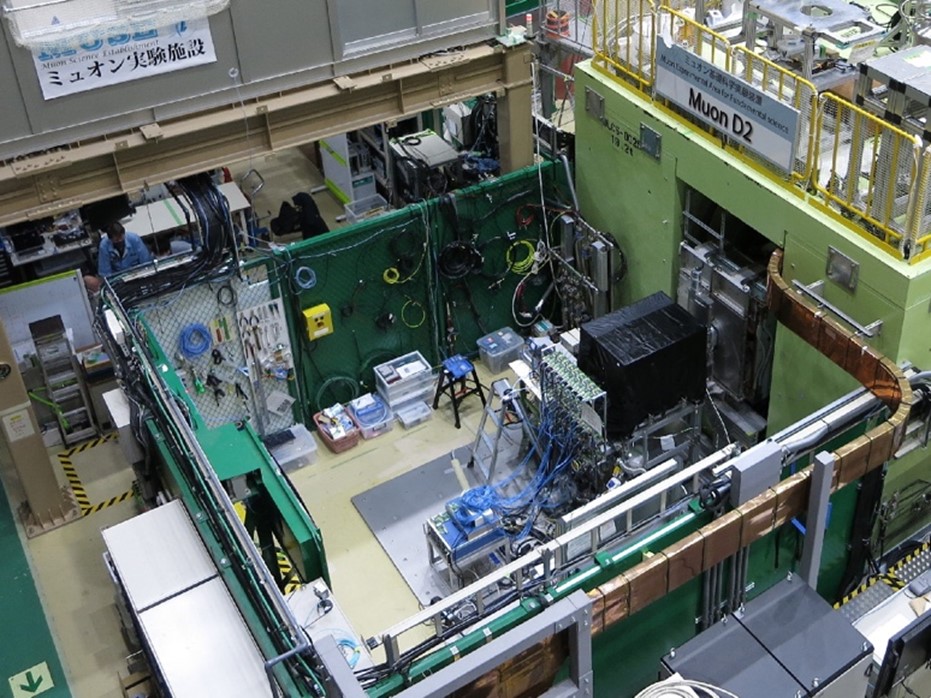
High Energy Accelerator Research Organization (KEK)
J-PARC Center
Nagoya University
School of Science, The University of Tokyo
STORY OF THIS RESEARCH
QUESTION
Muonic helium is composed of an ordinary helium atom with one of its two electrons replaced by a negative muon. Precision spectroscopy measurements of its energy structure can be used to determine the mass of the negative muon and verify the current theory of particle physics. However, this will require a hundredfold improvement over the accuracy of previous measurements.
FINDINGS
Muonic helium atom spectroscopy measurements at J-PARC MLF MUSE D-line were performed directly at zero magnetic field with a precision 3 times better than the previous measurement done in the 1980s. The result obtained is also more precise than the previous indirect measurement at high magnetic field improving the current world record precision by a factor of 1.5, establishing a highly precise spectroscopic method at J-PARC.
MEANING
This is an important milestone for the coming measurements at the H-line planned at high magnetic field that will allow us to measure the energy structure of muonic helium atoms a hundred times more precisely and determine the negative muon mass with greater precision to test CPT invariance by comparing the masses of positive and negative muons (second-generation leptons).
OVERVIEW
A muonic helium atom, which is composed of an ordinary helium atom with one of its two electrons replaced by a negative muon※1, is a special atom that is not found in nature. It has a small energy level structure, called hyperfine structure※2, that results from the interaction between the remaining electron and the negative muon (due to the intrinsic properties of their respective spin).
Precision spectroscopy measurements of the muonic helium atom hyperfine structure are the only available experimental results for three-body muonic atoms (i.e., helium nucleus, electron, and negative muon) that can be used to verify and improve the current theory of particle physics for three-body atomic system and quantum electrodynamics (QED), which accurately describes how matter and light interact at the quantum level. It can also be used to determine the mass of the negative muon to test CPT invariance by comparing the masses of positive and negative muons (second-generation leptons).
The hyperfine structure of muonic helium atoms has only been measured twice in the 1980s at the Paul Scherrer Institute in Switzerland (directly at zero magnetic field) and Los Alamos National Laboratory in the United States (indirectly at high magnetic field).
In this study, we succeeded in measuring the hyperfine structure of muonic helium atoms directly at zero magnetic field using the Muon Science Facility (MUSE) D-line at the Materials and Life Science Experimental Facility (MLF) of the Japan Proton Accelerator Research Complex (J-PARC※3) with a precision 3 times better than the previous direct measurement. The result obtained is also 1.5 times more precise than the previous indirect measurement at high field improving the current world record and establishing a highly precise spectroscopic method. It was also performed for the first time with methane admixture used as an electron donor to form neutral muonic helium atoms efficiently, the prerequisite to measuring the hyperfine structure.
This technique will soon be used at the H-line, which offers about ten times higher muon beam intensity than at the D-line and the possibility of longer measurement time. This will allow us to measure the hyperfine structure of muonic helium atoms at high magnetic field a hundred times more precisely and determine the negative muon mass with greater precision.
※1 Muon
A muon is an elementary particle with properties similar to the electron but with a mass about 200 times greater. Both positively and negatively charged muons exist. They can be found naturally in our surroundings, raining down to Earth from space as cosmic rays. However, muons decay in a very short time (about 2 microseconds lifetime). Negative muons can orbit nuclei the same way electrons do to produce a “muonic atom” with different characteristics from ordinary atoms because muons are much heavier.
※2 Hyperfine structure (HFS)
A small energy structure of an atom caused by the interaction between electrons and the nuclei. It is currently used in the cesium atomic clock to define the length of a second.
※3 J-PARC
J-PARC is a large-scale research facility jointly operated by the High Energy Accelerator Research Organization (KEK) and the Japan Atomic Energy Agency (JAEA) in Tokai-mura, Ibaraki Prefecture, Japan. J-PARC is a multi-purpose and multidisciplinary facility that is unique in the variety of secondary-particle beams produced and put to use in cutting-edge research across a wide range of scientific fields, from academic research in particle physics, nuclear physics, condensed matter physics, chemistry, materials science, and biology, to applied research in industrial fields.
RESEARCH GROUP
Institute for Materials Structure Science (IMSS), High Energy Accelerator Research Organization (KEK): P. Strasser (lecturer), R. Iwai (research fellow), S. Kanda (assistant professor), S. Nishimura (special assistant professor), and K. Shimomura (professor).
Department of Physics, Nagoya University: S. Fukumura (graduate student), S. Kawamura (graduate student), M. Kitaguchi (associate professor), H. M. Shimizu (professor), and H. Tada (graduate student).
Graduate School of Science, The University of Tokyo: H. A. Torii (associate professor).
Graduate School of Arts and Sciences, The University of Tokyo: S. Seo (graduate student).
A WORD FROM THE RESEARCHERS
There is nothing like good teamwork to achieve new scientific breakthroughs and reach exciting new frontiers.
CONTACT INFORMATION
RESEARCH RELATED INQUIRY (CORRESPONDING AUTHORS)
Muon Science Laboratory, Institute of Materials Structure Science (IMSS), High Energy Accelerator Research Organization (KEK)
Patrick Strasser
Laboratory for Particle Properties (Phi-lab), Department of Physics, Nagoya University
Masaaki Kitaguchi
PUBLIC RELATIONS
High Energy Accelerator Research Organization, Public Relations Office
Tel: 029-879-6047
E-mail: press@kek.jp
Please refer to the press release for details.
